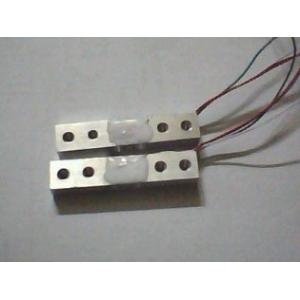

Add to Cart
0.3kfg 0.5kfg 1kfg Pocket Weight Scale Sensor Palm Jewelry Weight Cell CZT470
Load Cell Terminology
Each country has its own standard for the performance and quality
of load cells.In Japan, there is no standard stipulated uniquely
for load cells, although JIS(Load Cell - Test Method JIS B7602) and
JMIF (Japan Measuring Instruments Federation) prescribe methods for
performance tests.
Meanwhile, the OIML (International Organization of Legal Metrology)
sets the international recommendation titled “Metrological
Regulation for Load Cells,” with which each member country tries to
make their local regulation consistent.The terms described below
are commonly used by the OIML and its member countries.
Rated Capacity (RC)
The maximum load that a load cell can measure while meeting its
specifications.
Rated Output (RO)
The difference when there is no load and when there is a load of
rated capacity. It is generally expressed in output per excitation
voltage (mV/V). Alternatively called “Span.”
Safe load limit
The maximum load that can be applied beyond the rated capacity
without causing any permanent damage. Expressed as a percentage of
rated capacity.
Compensated temperature range
The temperature range within which the rated output and the zero
balance are compensated to meet the specifications.
Temperature effect on zero balance
Drifting of the zero balance caused by changes in the ambient
temperature.Expressed as a percentage of rated output.
Temperature effect on rated output
Drifting of the rated output caused by changes in the ambient
temperature.
Nonlinearity
The maximum deviation in output from the linear calibration curve
linking the zero balance and the rated output, which is measured
only when the load increases. Expressed as a percentage of rated
output.
Hysteresis error
The maximum difference in output between when the load increases
and when the load decreases.
Combined error
The maximum deviation of output from the linear calibration curve
linking the zero balance and the rated output, including when the
load increases and decreases.
Recommended/maximum excitation voltage
The voltage applied to the input terminals of load cell.
Zero balance
The electrical output when the rated excitation voltage is applied
without any load on the cell. Generally expressed as a percentage
of rated output.
Input terminal resistance
Measured while the output terminals are open, with no load on the
cell.
Output terminal resistance
Measured while the input terminals are open, with no load on the
cell.
Insulation resistance
The direct current resistance between the load cell unit and its
circuit.
Recommended excitation voltage 5-15V, maximum excitation voltage
15V.
Red (red): E+ black (black): E- white (white): V- blue or green (or
green blue): V+
Widely used in high precision, small measuring range weighing
occasions, with good lateral, torsional, anti offset properties for
miniature automatic detection equipment, compact test equipment,
trace weighing equipment, push and pull device, tension and
pressure testing, according to the user's requirements and
dimensions of custom sensors.
Optional fit weight transmitter, weighing display meter, weighing
control table, weighing alarm instrument (additional charge),
Where are load cells used?
Features
Ultra compact design
Adjusted for all kinds of loads.
Moisture proof
Wide model selection
| Technical | Unit | Data |
| Range | kg | 0.3/0.51 |
| Output sensitivity | mV/V | 1.0±0.15 |
| Synthetic error | %F.S | 0.03% |
| Zero drift | (30min)%F.S | 0.05/0.03 |
| Zero temperature drift | %F.S/10Deg C | 0.05/0.03 |
| Zero output | mV/V | ±0.1 |
| Input resistance | Ω | 1055±15 |
| Output resistance | Ω | 1000±5 |
| Overload capcity | %F.S | 200 |
Product Photos
